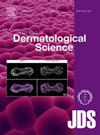在系统性硬化症中,CXCL4对周围血管病变和内皮细胞功能障碍的贡献。
IF 4
3区 医学
Q1 DERMATOLOGY
引用次数: 9
摘要
背景:cxcl4是一种具有抗血管生成特性的趋化因子,参与系统性硬化症(SSc)相关肺动脉高压(PAH)的发生。目的探讨体外循环CXCL4水平与外周血管病变的相关性,以及CXCL4对内皮细胞功能障碍和潜在信号通路的影响,探讨CXCL4在SSc发生中的作用。方法测定58例SSc患者、10例SSc早期诊断患者(VEDOSS)和80例健康对照(hc)的血浆CXCL4水平。然后,CXCL4浓度与临床特征,特别是周围血管病变相关。这些观察结果在另一个队列中得到进一步验证。此外,我们在体外研究了CXCL4在人脐静脉内皮细胞(HUVECs)中的抗血管生成作用及其潜在的下游信号传导。结果与匹配的hcc相比,SSc患者的循环CXCL4水平高103.62%,VEDOSS患者的循环CXCL4水平高201.51%,这在两个独立的队列中得到了证实。CXCL4水平与SSc的手指溃疡(DU)和甲襞视频毛细血管镜(NVC)异常有关。CXCL4或SSc源性血浆可抑制HUVECs的增殖、迁移和成管,CXCL4中和抗体可逆转HUVECs的增殖、迁移和成管,而CXCR3抑制剂则不能。CXCL4通过c-Abl信号通路下调Friend白血病整合因子-1 (Friend leukemia integration factor-1, fl -1)的表达。此外,CXCL4阻断了转化生长因子(TGF) -β或血小板衍生生长因子(PDGF)诱导的HUVECs细胞增殖。结论scxcl4可能通过内皮细胞c-Abl信号通路下调Fli-1并干扰血管生成,从而参与SSc外周血管病变。本文章由计算机程序翻译,如有差异,请以英文原文为准。
Contribution to the peripheral vasculopathy and endothelial cell dysfunction by CXCL4 in Systemic Sclerosis.
BACKGROUND
CXCL4, a chemokine with anti-angiogenic property, is involved in systemic sclerosis (SSc) related pulmonary arterial hypertension (PAH).
OBJECTIVE
To investigated the contribution of CXCL4 to SSc development by focusing on the correlation of circulatory CXCL4 levels with their peripheral vasculopathy, and the effect of CXCL4 on endothelial cell dysfunction and the potential signaling.
METHODS
We measured the plasma CXCL4 levels in 58 patients with SSc, 10 patients with the very early diagnosis of SSc (VEDOSS), and 80 healthy controls (HCs). Then, CXCL4 concentrations were correlated with clinical features, especially the peripheral vasculopathy. These observations were further validated in an additional cohort. Moreover, we studied the anti-angiogenic effects of CXCL4 and the underlying downstream signaling in human umbilical vein endothelial cells (HUVECs) in vitro.
RESULTS
Circulating CXCL4 levels were 103.62 % higher in patients with SSc and 201.51 % higher in patients with VEDOSS than matched HCs, which were confirmed in two independent cohorts. CXCL4 levels were associated with digital ulcers (DU) and nailfold videocapillaroscopy (NVC) abnormalities in SSc. The proliferation, migration, and tube formation of HUVECs were inhibited by CXCL4 or SSc derived plasma, which reversed by CXCL4 neutralizing antibody, but failed by CXCR3 inhibitor. CXCL4 downregulated the transcription factor Friend leukaemia integration factor-1 (Fli-1) via c-Abl signaling. Furthermore, CXCL4 blocked the transforming growth factor (TGF) -β or platelet-derived growth factor (PDGF) induced cell proliferation of HUVECs.
CONCLUSIONS
CXCL4 may contribute to peripheral vasculopathy in SSc by downregulating Fli-1 via c-Abl signaling in endothelial cells and interfering angiogenesis.
求助全文
通过发布文献求助,成功后即可免费获取论文全文。
去求助
来源期刊
CiteScore
7.60
自引率
2.20%
发文量
98
审稿时长
9.1 weeks
期刊介绍:
Although the Journal is the official organ of the Japanese Society for Investigative Dermatology, it serves as an international forum for the work of all dermatological scientists. With an internationally renowned Editorial Board, the Journal maintains high scientific standards in the evaluation and publication of manuscripts. The Journal also publishes invited reviews, commentaries, meeting announcements and book reviews. Letters to the Editor reporting new results or even negative scientific data, if they contribute to advances in dermatology are encouraged. Letters to the Editor should be less than 1000 words with up to 2 figures or tables.

 求助内容:
求助内容: 应助结果提醒方式:
应助结果提醒方式:


